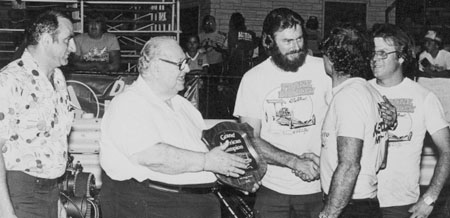 |
Within this time frame, AHRA made one more important contribution. As
some may know, the ‘65 AHRA Winter Nationals at Beeline marked
the debut of the altered wheelbase factory experimental cars. It was
at this race that these cars with the front ends aluminized and the
rear wheels moved forward two inches were referred to as “Funny
Cars.” They had their own eliminator and produced one of the most
historically important races of all time.
Order of qualifiers in Mr. Stock Eliminator at the 1965 AHRA Winternationals,
the race that produced the term “funny car.”
| 1. Sox & Martin - Ronnie Sox |
10.74 |
| 2. "Honker" - Bud Faubel |
10.84 |
| 3. The Ramchargers - Mike Buckel |
10.93 |
| 4. "The Golden Commandos" - Al Eckstrand |
10.98 |
| 5. "Melrose Missile" - Tommy Grove |
11.03 |
| 6. "Color Me Gone" - Roger Lindamood |
11.12 |
| 7. Forest Pitcock |
11.14 |
| 8. "Flying Carpet" - Bob Harrop |
11.16 |
| 9. Dave Strickler |
11.18 |
| 10. Baney Plymouth - Preston Honea |
11.19 |
| 11. "Black Arrow" - Bill Jenkins |
11.26 |
| 12. Fenner Tubbs Plymouth - Joe Smith |
11.27 |
| 13. Lee Smith |
11.33 |
| 14. Sites Bros./"Missouri Mule" - Dr. Dick
Spence |
11.41 |
| 15. Dick Housey |
11.48 |
| 16. Melton & Snow - Gene Snow |
11.54 |
**Dick Landy, Butch Leal, and Phil Bonner had all qualified for the
show, but were unable to make eliminations due to mechanical difficulty.
THE FINAL: Bud Faubel - 10.96 / 129.31 over Eckstrand.
It should be noted that the eliminator at the ‘65 AHRA Winternationals
was referred to as Mr. Stock Eliminator and the term “Funny Car”
was never used in race coverage such as that of Drag Racing magazine.
In that May 1965 issue, the only snide comment was reported as follows:
“As of this writing, Ford has instructed their drivers to steer
clear of the so-called “bogus” Mopars and not enter a meet
where they are allowed. As most know, the Mopars were made more conservative
(no altered wheelbases, reportedly more weight) and were soundly thrashed
by the Fords.
Somehow, through all of this, some unknown person or persons, came
up with the slug “funny car” and a class name stuck.
What was NHRA doing during all of this? The California hot rod group
stuck to four national events through the 1969 season and about as half
as many classes. One advantage the NHRA team had, among other things,
was promotional ability; every one of their races was slicker and more
professional and as a result they got more television and print coverage.
Still, by the end of the 1960’s, AHRA was providing NHRA with
all the competition they could handle, and with the Grand American Series
of Professional Drag Racing introduced in 1970, the ante went up even
more.
 |
| Still, by the end of the 1960’s, AHRA
was providing NHRA with all the competition they could handle, and
with the Grand American Series of Professional Drag Racing introduced
in 1970, the ante went up even more. |
Next month, we continue the AHRA saga, beginning in 1970 with the
organization’s GRAND AMERICAN SERIES
 |
page 6 of 6 |
|
|